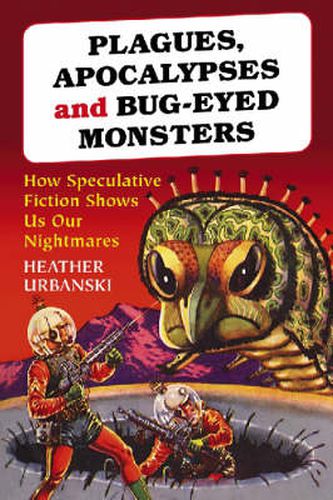Readings Newsletter
Become a Readings Member to make your shopping experience even easier.
Sign in or sign up for free!
You’re not far away from qualifying for FREE standard shipping within Australia
You’ve qualified for FREE standard shipping within Australia
The cart is loading…






This title is printed to order. This book may have been self-published. If so, we cannot guarantee the quality of the content. In the main most books will have gone through the editing process however some may not. We therefore suggest that you be aware of this before ordering this book. If in doubt check either the author or publisher’s details as we are unable to accept any returns unless they are faulty. Please contact us if you have any questions.
Speculative fiction - both science fiction and fantasy - reflects, among other things, the fears of the culture that created it, contributing (perhaps unconsciously) to our efforts to prevent our fears from coming true. While the names and media change over time, the themes of speculative fiction have a long history. Nineteenth century works such as
Frankenstein
and
The Invisible Man
contain many of the same messages as the more modern tales of
Terminator ,
Jurassic Park
and even
Buffy, the Vampire Slayer , although almost a century separates their creation. This critical study discusses the ways in which speculative fiction reflects societal fears and analyzes how such cautionary tales contribute to society’s efforts to avoid the realization of these fears. Beginning with a discussion of the nature of speculative fiction, it takes a look at the characteristics of the cautionary tale. The core of the book, however, is the concept of the
Nightmares Model,
which examines and categorizes the repetition of specific themes within the genre. The dangers of science and technology, the perils of power, and the threat of the unknown are discussed as recurrent themes within a variety of works in prose, film and television. The works analyzed range from
Twenty-Thousand Leagues Under the Sea
to
2001: A Space Odyssey
to
The Blair Witch Project . Sources include the author’s own observations as a member of the genre’s fandom, a variety of published commentaries and the perspectives of contemporary professionals gained through personal interviews and panel discussions.
$9.00 standard shipping within Australia
FREE standard shipping within Australia for orders over $100.00
Express & International shipping calculated at checkout
This title is printed to order. This book may have been self-published. If so, we cannot guarantee the quality of the content. In the main most books will have gone through the editing process however some may not. We therefore suggest that you be aware of this before ordering this book. If in doubt check either the author or publisher’s details as we are unable to accept any returns unless they are faulty. Please contact us if you have any questions.
Speculative fiction - both science fiction and fantasy - reflects, among other things, the fears of the culture that created it, contributing (perhaps unconsciously) to our efforts to prevent our fears from coming true. While the names and media change over time, the themes of speculative fiction have a long history. Nineteenth century works such as
Frankenstein
and
The Invisible Man
contain many of the same messages as the more modern tales of
Terminator ,
Jurassic Park
and even
Buffy, the Vampire Slayer , although almost a century separates their creation. This critical study discusses the ways in which speculative fiction reflects societal fears and analyzes how such cautionary tales contribute to society’s efforts to avoid the realization of these fears. Beginning with a discussion of the nature of speculative fiction, it takes a look at the characteristics of the cautionary tale. The core of the book, however, is the concept of the
Nightmares Model,
which examines and categorizes the repetition of specific themes within the genre. The dangers of science and technology, the perils of power, and the threat of the unknown are discussed as recurrent themes within a variety of works in prose, film and television. The works analyzed range from
Twenty-Thousand Leagues Under the Sea
to
2001: A Space Odyssey
to
The Blair Witch Project . Sources include the author’s own observations as a member of the genre’s fandom, a variety of published commentaries and the perspectives of contemporary professionals gained through personal interviews and panel discussions.